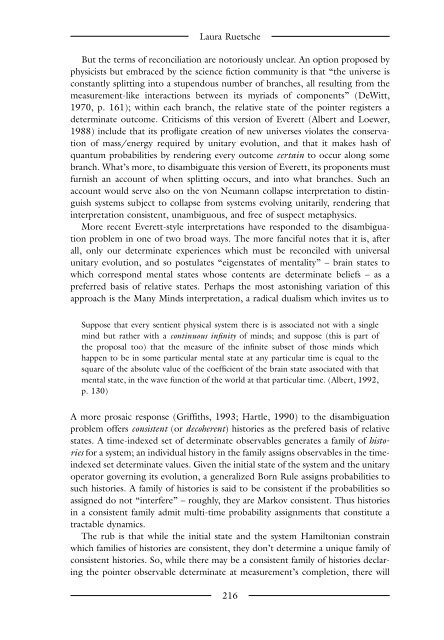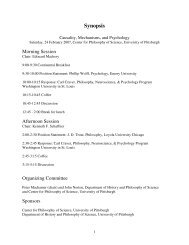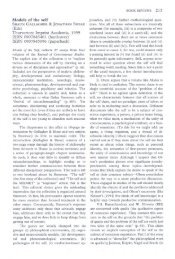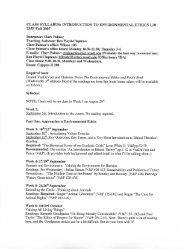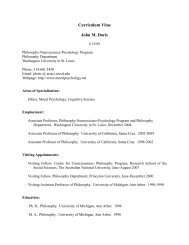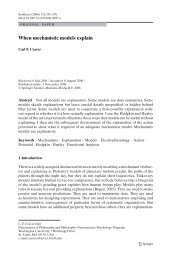The Blackwell Guide to the Philosophy of Science - The Department ...
The Blackwell Guide to the Philosophy of Science - The Department ...
The Blackwell Guide to the Philosophy of Science - The Department ...
You also want an ePaper? Increase the reach of your titles
YUMPU automatically turns print PDFs into web optimized ePapers that Google loves.
Laura Ruetsche<br />
But <strong>the</strong> terms <strong>of</strong> reconciliation are no<strong>to</strong>riously unclear. An option proposed by<br />
physicists but embraced by <strong>the</strong> science fiction community is that “<strong>the</strong> universe is<br />
constantly splitting in<strong>to</strong> a stupendous number <strong>of</strong> branches, all resulting from <strong>the</strong><br />
measurement-like interactions between its myriads <strong>of</strong> components” (DeWitt,<br />
1970, p. 161); within each branch, <strong>the</strong> relative state <strong>of</strong> <strong>the</strong> pointer registers a<br />
determinate outcome. Criticisms <strong>of</strong> this version <strong>of</strong> Everett (Albert and Loewer,<br />
1988) include that its pr<strong>of</strong>ligate creation <strong>of</strong> new universes violates <strong>the</strong> conservation<br />
<strong>of</strong> mass/energy required by unitary evolution, and that it makes hash <strong>of</strong><br />
quantum probabilities by rendering every outcome certain <strong>to</strong> occur along some<br />
branch. What’s more, <strong>to</strong> disambiguate this version <strong>of</strong> Everett, its proponents must<br />
furnish an account <strong>of</strong> when splitting occurs, and in<strong>to</strong> what branches. Such an<br />
account would serve also on <strong>the</strong> von Neumann collapse interpretation <strong>to</strong> distinguish<br />
systems subject <strong>to</strong> collapse from systems evolving unitarily, rendering that<br />
interpretation consistent, unambiguous, and free <strong>of</strong> suspect metaphysics.<br />
More recent Everett-style interpretations have responded <strong>to</strong> <strong>the</strong> disambiguation<br />
problem in one <strong>of</strong> two broad ways. <strong>The</strong> more fanciful notes that it is, after<br />
all, only our determinate experiences which must be reconciled with universal<br />
unitary evolution, and so postulates “eigenstates <strong>of</strong> mentality” – brain states <strong>to</strong><br />
which correspond mental states whose contents are determinate beliefs – as a<br />
preferred basis <strong>of</strong> relative states. Perhaps <strong>the</strong> most as<strong>to</strong>nishing variation <strong>of</strong> this<br />
approach is <strong>the</strong> Many Minds interpretation, a radical dualism which invites us <strong>to</strong><br />
Suppose that every sentient physical system <strong>the</strong>re is is associated not with a single<br />
mind but ra<strong>the</strong>r with a continuous infinity <strong>of</strong> minds; and suppose (this is part <strong>of</strong><br />
<strong>the</strong> proposal <strong>to</strong>o) that <strong>the</strong> measure <strong>of</strong> <strong>the</strong> infinite subset <strong>of</strong> those minds which<br />
happen <strong>to</strong> be in some particular mental state at any particular time is equal <strong>to</strong> <strong>the</strong><br />
square <strong>of</strong> <strong>the</strong> absolute value <strong>of</strong> <strong>the</strong> coefficient <strong>of</strong> <strong>the</strong> brain state associated with that<br />
mental state, in <strong>the</strong> wave function <strong>of</strong> <strong>the</strong> world at that particular time. (Albert, 1992,<br />
p. 130)<br />
A more prosaic response (Griffiths, 1993; Hartle, 1990) <strong>to</strong> <strong>the</strong> disambiguation<br />
problem <strong>of</strong>fers consistent (or decoherent) his<strong>to</strong>ries as <strong>the</strong> prefered basis <strong>of</strong> relative<br />
states. A time-indexed set <strong>of</strong> determinate observables generates a family <strong>of</strong> his<strong>to</strong>ries<br />
for a system; an individual his<strong>to</strong>ry in <strong>the</strong> family assigns observables in <strong>the</strong> timeindexed<br />
set determinate values. Given <strong>the</strong> initial state <strong>of</strong> <strong>the</strong> system and <strong>the</strong> unitary<br />
opera<strong>to</strong>r governing its evolution, a generalized Born Rule assigns probabilities <strong>to</strong><br />
such his<strong>to</strong>ries. A family <strong>of</strong> his<strong>to</strong>ries is said <strong>to</strong> be consistent if <strong>the</strong> probabilities so<br />
assigned do not “interfere” – roughly, <strong>the</strong>y are Markov consistent. Thus his<strong>to</strong>ries<br />
in a consistent family admit multi-time probability assignments that constitute a<br />
tractable dynamics.<br />
<strong>The</strong> rub is that while <strong>the</strong> initial state and <strong>the</strong> system Hamil<strong>to</strong>nian constrain<br />
which families <strong>of</strong> his<strong>to</strong>ries are consistent, <strong>the</strong>y don’t determine a unique family <strong>of</strong><br />
consistent his<strong>to</strong>ries. So, while <strong>the</strong>re may be a consistent family <strong>of</strong> his<strong>to</strong>ries declaring<br />
<strong>the</strong> pointer observable determinate at measurement’s completion, <strong>the</strong>re will<br />
216


